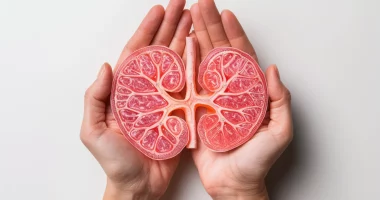Periodontitis
Overview
Periodontitis, a chronic inflammatory oral disease, gradually damages the structures supporting teeth. It often starts as worsened gingivitis and, if left untreated, can result in tooth loosening and loss. Symptoms, such as pain and swelling, are rare except in HIV patients or when abscesses develop. Diagnosis relies on examination, periodontal probing, and x-rays, with treatment involving deep dental cleaning, home hygiene, and, in severe cases, antibiotics and surgery. Preventive measures include regular brushing, daily flossing, and routine dental checkups to safeguard against periodontitis, a severe form of gum disease that can lead to tooth loss by inflaming gum tissue and eroding the tooth-supporting bone.
Classification of Periodontitis
The American Academy of Periodontology (AAP), in its 2017 classification of periodontal diseases and conditions, initially categorized periodontitis into three distinct forms.
Necrotizing periodontitis
Necrotizing periodontitis is an aggressive condition characterized by:
- Necrosis or ulceration of interdental papillae
- Bleeding gums
- Pain
It primarily affects individuals with weakened immune systems, often due to HIV. Clinically, it resembles a combination of acute necrotizing ulcerative gingivitis and aggressive periodontitis, causing significant attachment loss in six months. In severe cases, it may extend into the oral cavity, causing necrotizing stomatitis.
Periodontitis as a manifestation of systemic disease
Periodontitis linked to systemic diseases results from inflammation disproportionate to local factors and systemic conditions. Distinguishing between disease causation and contribution to plaque-induced periodontitis can be challenging. Systemic diseases associated with hematologic conditions leading to periodontitis include acquired neutropenia, agranulocytosis, leukemias, lazy leukocyte syndrome, and hypogammaglobulinemia. Genetic disorders related to periodontitis encompass familial and cyclic neutropenia, Down syndrome, leukocyte adhesion deficiency syndromes, Papillon-Lefèvre syndrome, Chédiak-Higashi syndrome, histiocytosis syndromes, infantile genetic agranulocytosis, Ehlers-Danlos syndrome, hypophosphatasia, Cohen syndrome, and Crohn’s disease.
Periodontitis
However, a new classification scheme for periodontitis has since been adopted. The previously recognized “chronic” and “aggressive” forms have been consolidated into a category termed periodontitis. Key factors determining the severity of periodontitis include:
- The extent of soft tissue attachment loss to teeth.
- The depth of periodontal pockets.
- The degree of bone loss visible on x-rays.
Causes
Main Cause: Poor Oral Hygiene
The primary cause of periodontitis is inadequate oral hygiene. Bacteria adhere to plaque and tartar on the surfaces of your teeth. When proper teeth cleaning practices are not followed, these harmful bacteria migrate beneath the gum line, beyond the reach of your toothbrush and floss. There, they initiate a destructive process, eroding the supportive tissues around your teeth, resulting in infection, bone loss, and eventual tooth loss.
Contributing Factors
Several factors can elevate your risk of developing periodontitis, including:
- Smoking: Smoking significantly weakens the body’s ability to combat infections, making it a prominent risk factor.
- Diabetes: Individuals with diabetes are more susceptible to infections, including periodontitis.
- Genetics: Your genetic background and family history can increase your vulnerability to gum disease.
- Hormonal Changes: Hormonal fluctuations in women, such as those during pregnancy or while using birth control pills, can heighten the likelihood of developing periodontitis.
- Obesity
- Emotional stress
- Vitamin C deficiency (scurvy)
- Inflammatory Health Conditions: Diseases that provoke systemic inflammation, such as arthritis, COVID-19, and cardiovascular disease, have links to periodontitis.
Diagnosis
To diagnose periodontitis, a dentist will:
- Inquire about your symptoms and medical history.
- Examine your gums for signs of inflammation.
- Utilize a periodontal probe, resembling a tiny ruler, to assess the presence of pockets around your teeth, which is painless.
- Perform dental X-rays to evaluate potential bone loss.
In some cases, refer you to a periodontist, a specialist in gum diseases.
The clinical assessment and probing pocket depths and measuring them are typically adequate for diagnosis. Pockets deeper than 3.5 mm are often indicative of periodontitis. Dental X-rays can also reveal alveolar bone loss.
Treatment
Treatment for periodontitis varies depending on the severity of the condition. It can be administered by a dentist or a periodontist specializing in gum diseases. Dental hygienists may also play a role in your treatment plan. The primary goal of treatment is to effectively clean the pockets around your teeth, preventing damage to the surrounding gum tissue and bone. Successful treatment is best achieved when combined with a daily oral care routine, managing health conditions impacting dental health, and discontinuing tobacco use.
Nonsurgical treatment
Nonsurgical treatments are typically employed for less advanced cases of periodontitis and may include:
- Scaling: Removal of tartar and bacteria from tooth surfaces and below the gumline using instruments, lasers, or ultrasonic devices.
- Root Planing: Smoothing root surfaces to discourage further plaque and bacteria accumulation to facilitate gum reattachment.
- Antibiotics: Topical or oral antibiotics to control bacterial infection, sometimes administered through mouth rinses or gels in gum pockets. In many instances, amoxicillin and metronidazole are the preferred antibiotics for treatment.
Surgery
For advanced periodontitis, surgical interventions may be necessary, including:
- Flap Surgery (Pocket Reduction Surgery): Incisions are made in the gums to expose tooth roots for thorough scaling and root planing. Reshaping of underlying bone may aid in cleaning and tissue healing.
- Soft Tissue Grafts: Damaged gum tissue is reinforced, often using tissue from the roof of the mouth or another donor source, to cover exposed tooth roots and improve appearance.
- Bone Grafting: When bone loss has occurred, grafts made from various materials are used to hold teeth in place, prevent tooth loss, and support natural bone regrowth.
- Guided Tissue Regeneration: A membrane between existing bone and the tooth encourages bone regrowth and prevents unwanted tissue growth.Periodontal regenerative procedures are currently experiencing a rise in popularity. It is performed in more than 175 clinics worldwide (https://doctor.global/results/procedures/periodontal-regenerative-procedures). The cost can vary based on the complexity of the case. For instance, such a procedure is priced at 479EUR in Limassol, Greece. (https://doctor.global/clinic/dr-stephanos-tsitsis-dental-implant-surgery-clinic#prices).
- Tissue-Stimulating Proteins: A special gel containing proteins similar to those found in developing tooth enamel is applied to stimulate healthy bone and tissue growth.
Additionally, treatment may involve addressing modifiable risk factors such as poor oral hygiene, diabetes, and smoking to enhance treatment outcomes. Thorough scaling and root planing, sometimes coupled with systemic antibiotics, are typically the initial steps in treatment. Surgical procedures, pocket reduction surgery, and bone grafts may be considered for more severe cases. Control of contributing systemic factors is essential before starting periodontal therapy.


